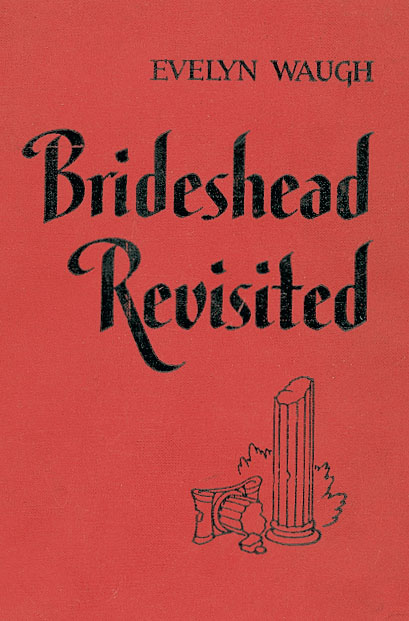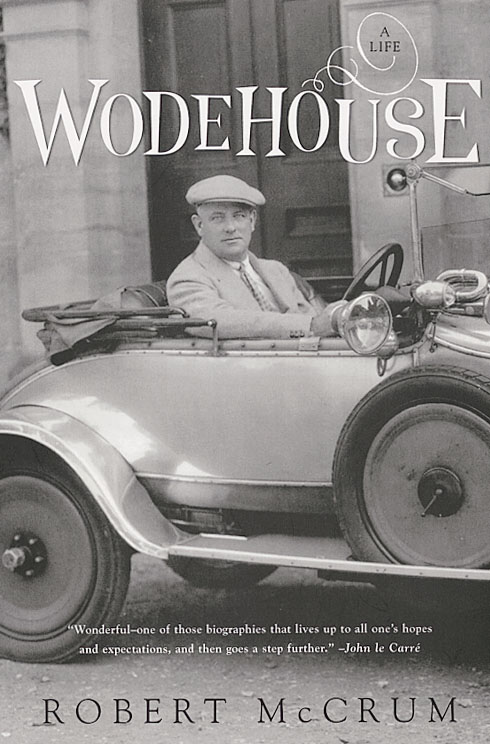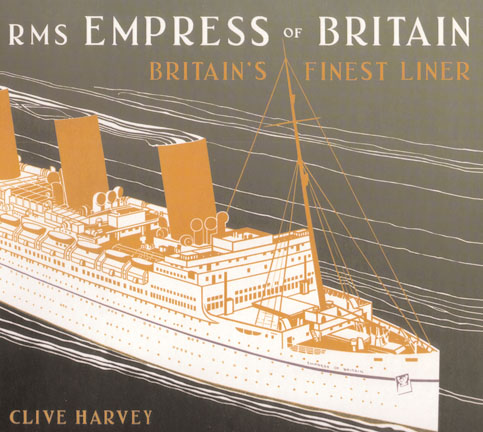
THIS ISSUE, WE PUT on the bookshelf tales that offer a vision of life in the British aristocracy between the two world wars. The first of these is the next in our series of glimpses at those books our readers’ poll indicated were the most British books of all time: Brides head Revisited,by Evelyn Waugh. Upper-class England gets a very different treatment with the unique humor of novelist P.G. Wodehouse. And what better time in history to revisit the story of the Duke and Duchess of Windsor. What each of these grand reads shares in common, characters and authors alike, is that they all probably crossed the Atlantic on RMS Empress.
Brideshead Revisited, by Evelyn Waugh. Available in many editions, soft and hardcover.
[caption id="TheLatestBooksaboutBritain_img1" align="aligncenter" width="409"]

“It was about eleven when Sebastian, without warning, turned the car into a cart track and stopped. It was hot enough now to make us seek the shade. On a sheep-cropped knoll under a clump of elms we ate the strawberries and drank the wine—as Sebastian promised, they were delicious together—and we lit fat, Turkish cigarettes, and lay on our backs, Sebastian’s eyes on the leaves above him, mine on his profile, while the blue-grey smoke rose, untroubled by any wind, to the blue-green shadows of foliage, and the sweet scent of tobacco merged with the sweet summer scents around us and the fumes of the sweet, golden wine seemed to lift us a finger’s breadth above the turf and hold us suspended.”
IN THE SALAD DAYS of college I first read Brideshead Revisited. Now, a generation later I returned to Evelyn Waugh’s poignant novel as part of our series on the most British books of all time. Amazed I was to discover how much the novel has changed over the years.
To everything we read, we bring ourselves—the light fantastic of our experience, the scars of soul and serendipity of learning. No great novel is ever the same when we approach it for a second time or third after intervening years, for we are not the same reader. Like Charles Ryder, whose story this is, we return to a place both familiar and strange.
That place here is the stately home of Brideshead, ancestral seat of the Marquis of Marchmain. Like William Faulkner and F. Scott Fitzgerald at their best, Evelyn Waugh has the gift for transporting the reader with a sense of place at once tangible and spiritual, to Brideshead, or to the halcyon days of an Oxford term, complete with strawberries and wine.
What could be more tangible than Brideshead? Within its alabaster walls, generations of knights and knaves, saints and sinners, lived out their noblesse oblige in grandeur, security and continuity. Of course, the fortress that protects can also imprison. It is not the majestic and sumptuous mansion itself that imprisons the Flyte family, but the ghosts of its past, and the very nuances of England itself. As a prominent Catholic line in a Protestant country, each member in their own way feels a weight of spiritual responsibility few outside the walls of Brideshead can understand. House and family are the same.
These are the years between the wars, when Britain still reeled from its loss of a million men in the trenches of the Western Front, and when the clouds of fascism gathered and darkened in the skies over Europe. Artistic and agnostic, Charles Ryder was one of the Lost Generation. To Brideshead he comes, first as the intimate of the tormented and wastrel Sebastian, later as the lover of the beautiful apostate Julia. Into their lives and the lives of their family, Charles brings a sensitive and perceptive outsider’s eye. He sees it all, and records it all, but understands nothing. Charles is as set apart from the Flytes as they themselves are from the England of their tenants and their king.
Layer upon layer, Evelyn Waugh weaves the tale of searchers, of sailors on lonely seas, who do at last reach peace in their own harbors: Sebastian and Julia, Lord Marchmain and Charles, and the reader as well if we join their search.
Brideshead Revisited makes our list of the most British books of all time because it captures with such subtlety and color both the beauty and the pain attendant on living in England’s history. It is not hard, lying on the sheep-cropped knolls of England’s green and pleasant land, to be lifted by the glories of its past—2,000 years of Shakespeare and Agincourt, Beckett, Churchill and Nelson—just that finger’s breadth above the turf. It is often much harder to stay firmly on the ground.
Yes, at Brideshead and Castle Howard, Longleat and Chatsworth, it may take on a special weight, amidst ancestral tombs and tomes, but deep at heart every English man and woman from pub to palace lives with our Lord’s words echoing behind them, “For of those to whom much is given, much is required.”
DANA HUNTLEY
Wodehouse: A Life, by Robert McCrum, W.W. Norton & Co. Inc., New York, 2004, 530 pages, $27.95.
ROBERT MCCRUM’S authoritative new biography covers one of the most widely read, most beloved and most controversial British writers of the 20th century. During the course of his 93-year lifetime P.G. Wodehouse wrote 97 novels, 300 short stories, 500 articles and essays, 16 plays and the lyrics for 23 musical comedies. Beyond those sterile statistics, Wodehouse created a hilarious, and largely artificial, British parallel universe that will continue to delight readers throughout the world for generations to come. His most famous, and most characteristic, literary creations were the feather-headed young toff Bertie Wooster and his sagacious valet: the immortal Jeeves.
[caption id="TheLatestBooksaboutBritain_img2" align="aligncenter" width="490"]

One of those ancient English family names established long before the advent of dictionaries, the correct pronunciation of Pelham Grenville Wodehouse’s surname was “Woodhouse.” Not surprisingly, the writer often created characters with similarly eccentric English names, such as “Featherstonehaugh” (pronounced Fanshaw), “Mapledurham” (pronounced Mum), “Blicester” (pronounced Blister) and “Psmith” (pronounced Smith). Wodehouse, who disliked the name Pelham, was known to close friends as “Plum.” The author took great delight in bestowing ridiculous nicknames upon his upper-class characters—appellations such as “Balmy,” “Bingo,” “Pongo” and “Kipper.”
The England about which Wodehouse wrote was as delightful, and nearly as imaginary, as the Middle Earth of J.R.R. Tolkien’s Lord of the Rings. Born in 1881, Pelham Grenville Wodehouse grew up in Victorian England and established his literary career in Edwardian England. The great social, economic and political upheavals of the 20th century scarcely affected the idyllic world of Mayfair clubs and country house parties. Neither the Depression nor the two world wars touched the “English Arcadia” of Wodehouse’s patrician protagonists and their faithful family retainers.
As McCrum makes clear, the unreality of Wodehouse’s Britain was largely based upon the fact that the writer lived much of his life abroad. He spent World War I establishing himself as a writer in the United States, where he introduced the memorable character of Jeeves in 1916. Wodehouse resided in the United States during the interwar period as well, dividing his time between Broadway and Hollywood. He worked with some of the greatest names in entertainment, people such as Jerome Kern, George Gershwin and Cole Porter. Through it all he maintained the air of negligent detachment that was to stand him in good stead during World War II and to get him into hot water afterward. Widely (and, according to McCrum, unfairly) accused of collaborating with the enemy in his native Britain, Wodehouse returned to the United States after the war, eventually became a U.S. citizen and lived there until his death.
[caption id="TheLatestBooksaboutBritain_img3" align="aligncenter" width="480"]

The most controversial period of Wodehouse’s life encompassed World War II. Residing in northern France, he was one of many expatriate civilians overtaken by the rapidity of the German blitzkrieg of May 1940. The writer spent the war interned by the Germans, among whom he “accommodated himself to the vicissitudes of fate” as best he could. Intending only to “demonstrate how a little group of British people were keeping up their spirits in difficult conditions, ” he agreed to broadcast anecdotes of his internment over German radio. Though he was by no means a Nazi sympathizer, that action led to accusations of collaboration, and even treason, that haunted Wodehouse for the rest of his life.
Wodehouse: A Life is a fascinating biography. Fans of P.G. Wodehouse will undoubtedly enjoy Robert McCrum’s perceptive new appraisal of the quintessentially British writer who was far more complex than he himself, in his typically self-deprecating fashion, ever cared to admit.
ROBERT GUTTMAN
The Duchess of Windsor: The Secret Life, by Charles Higham, published by John Wiley & Sons, Inc., New Jersey, 560 pages, softcover $19.95.
INFIDELITY, INTRIGUE, sex, espionage… Charles Higham leaves very little out of his revised edition of The Duchess of Windsor: The Secret Life. The result is an unflattering portrait of a fascinating and complex woman—Wallis Warfield Simpson. This thoroughly researched biography begins with Simpson’s 1895 illegitimate birth into a wealthy Baltimore, Md., family. As a young girl she had high material ambitions that were disappointed by her first two marriages. When in 1929 she traveled to London with her second husband, Ernest Simpson, she set her sights on the Prince of Wales and succeeded in worming her way into his inner circle to ultimately become his mistress.
Higham tells of a relationship between the two in which Mrs. Simpson acted as a mother figure to a sadly impotent middle-aged man. The author relates more than one episode taken from first-person observations of Simpson publicly scolding the Prince, and he responding with subservience. It seems to have been just what the Prince needed, because his devotion to her never wavered, even when he succeeded to the British throne on the death of his father King George V on January 19, 1936. The author gives nearly day-by-day detail of the following months that culminate with Edward VIII’s December 1936 abdication of the throne, because as king he would not be allowed to marry the twice-divorced Simpson. Outwardly, the abdication seems very straightforward—that of a man so much in love that he gave up his kingdom. What Higham reveals, however, is two very self-absorbed, spoiled and slightly silly people in a rather insidious relationship.
Even more alarming is Higham’s contention that Simpson was an undercover German agent. That she and the Prince admired Adolf Hitler and supported Italy’s Benito Mussolini is no secret. Furthermore, Simpson’s associations with known German spies and high-ranking officials caught and held the attention of Britain’s Secret Intelligence Service. After the couple married in June 1937, and the former king carried no political weight, they continued to pay court to Hitler and even visited him in Germany not long after their wedding.
That Wallis Warfield Simpson was a gold digger is no surprise. The depth of her duplicitous and petty nature, however, is a revelation. After the abdication, Edward VIII became the Duke of Windsor and went into exile. Up until his death in 1972, he and the Duchess pestered the royal family to permit her the title “Her Royal Highness,” but it was denied her. She blamed this slight and many others on Queen Elizabeth (wife of the Duke’s brother, George VI). The Duchess of Windsor showed her bitterness in such unattractive ways as making fun of how the much-beloved Queen dressed. There was no love lost between the two women, as Queen Elizabeth blamed the Duchess for her own husband’s early death after being forced to the throne and reigning as king through the horrors of World War II. Their one attempt at a reconciliation was spoiled by the Duchess’ illness, and the physical and mental decline that ultimately led to her death in 1986.
Aside from its lacking a proper bibliography, little fault can be found with this well-researched character study. Simpson appears with all her thorns, yet for all that she inspired something noteworthy. The couple’s devotion to one another appeared to grow over the years, and the Duchess was devastated when her husband died. “He was my entire life,” the Duchess confided to Prince Charlesand Lord Mountbatten. “I can’t begin to think what I will do without him, he gave up so much for me, and now he has gone. I always hoped I would die before him.”
After her death, found among her effects was a small framed illuminated manuscript with a verse by an anonymous poet: “My friend to live with thee alone / I think t’were better than to own / A crown, a scepter or a throne.” A coronet sits above the text.
ALLYSON PATTON
RMS Empress of Britain: Britain’s Finest Liner, by Clive Harvey, published by Tempus Publishing, Gloucestershire, 96 pages, $40.
[caption id="TheLatestBooksaboutBritain_img4" align="aligncenter" width="483"]

“THIS VESSEL CAN be considered in construction as the last word in shipbuilding, and as regards her appointments—she will have no rivals,” observed His Royal Highness the Prince of Wales at the 1931 launching of Empress of Britain, the newest addition to the Canadian Pacific Line. The Prince presided over the ceremony and was most impressed by what he saw. At 760 feet long, the ship boasted opulent and spacious first-class apartments as well as sumptuous public rooms with decorative schemes designed by some of Britain’s best known artists, including W. Heath Robinson, Edmund Dulac and Sir John Lavery.
Empress of Britain was not built just for luxury, however. At 42,348 tons and capable of accommodating 1,195 passengers at an average speed of 24 knots, it was the Canadian Pacific’s largest and fastest ship. On its maiden voyage, Empress made record time from Southampton to Quebec and continued to lower its time during the course of its first season of operation. Called “the finest vessel ever launched,” none equaled Empress of Britain in service between Europe and Canada.
In RMS Empress of Britain: Britain’s Finest Liner, author Clive Harvey gives a comprehensive history and detailed descriptions of the splendid liner. Ship diagrams, artists’ renditions and a multitude of historic black-and-white photographs saturate this book, transporting the reader back to the golden age of cruise liners. Empress of Britain’s first season’s passenger list reads like a “Who’s Who” of the time and included Mary Pickford and Douglas Fairbanks, who found two faults on his cruise. The first was that the voyage was too short to enjoy all of the ship’s many attractions, and the second was that those same attractions distracted from the actual ocean voyage.
Harvey surrounds the history of Empress of Britain with the story of the Canadian Pacific Line, and after World War I, even with an economic depression to contend with, both the ship and the company seemed destined for greatness. The onset of World War II, however, changed all of that. Like many other commercial ships of its size, Empress of Britain went into wartime service in November 1939. For 11 months it served as a troop transport ship, until October 26, 1940, when the liner was spotted by a German Condor reconnaissance plane just 60 miles off the coast of Ireland. The pilot bombarded Empress of Britain with incendiary bombs until it was fully ablaze. Ordered to abandon ship, all but 45 of the 643 aboard survived the ordeal and were rescued by naval vessels. Two days later, while under tow, it was torpedoed and sunk by a German U-boat.
As tragic as its loss was, the Quebec Chronicle-Telegraph aptly observed, “How much more fitting that she should find a water grave in the service of her country than that she should be broken up for scrap metal, the fate that would normally have overtaken her.”
Harvey notes that Empress of Britain was a liner of its times. It couldn’t have been built before World War I, nor would it have fit “into the brave new world of the 1950s.” The story of Empress is a good one, and Harvey tells it well.
ALLYSON PATTON





Comments